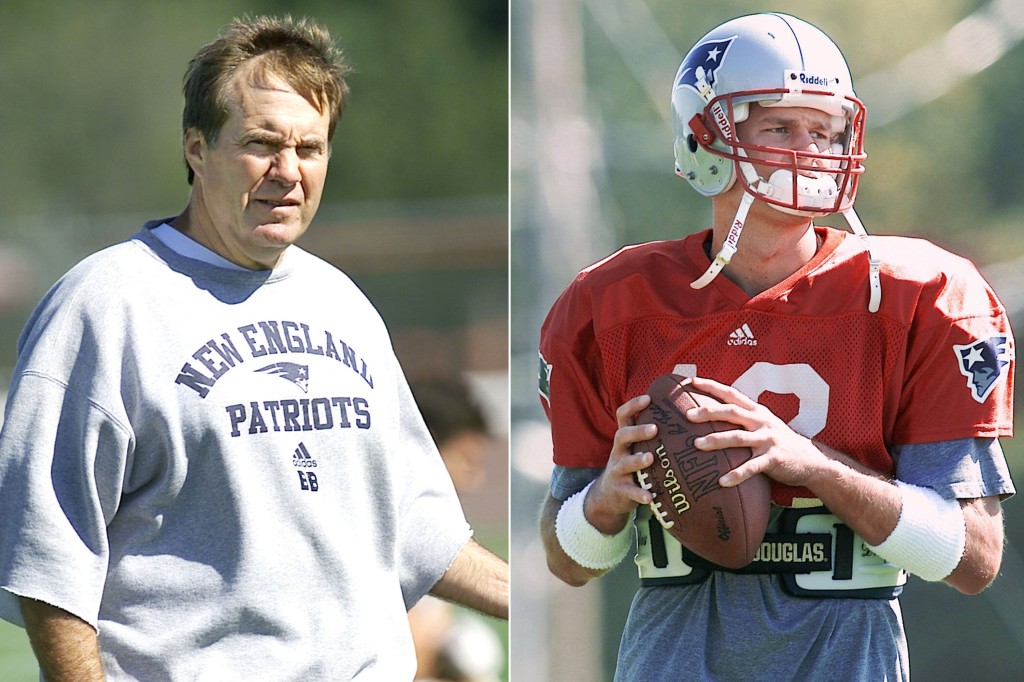The official play-by-play account is cold, detached, antiseptic, cold-blooded. It feels like it should have been presented in bold-face type, or all caps, given what a seminal moment in football history it was. But it doesn’t work that way in real time. So when you dig through the archives, this is what you see:
5:11. 3 & 10, NWE 19. Drew Bledsoe, right end for 8 yards (tackle by Mo Lewis). Bledsoe fumbles (forced by Lewis), ball out of bounds at NWE 27.
Twenty years, one month and one day later, we know exactly what happened in that crashing, crushing instant. We know that Bledsoe came close to dying in the ambulance later on as the result of his injury (though he somehow managed to play one more series before being pulled from the game), and that doctors told him if he’d simply gone home that night and fallen asleep, he might well never have woken up again.
We know that the backup quarterback who replaced him for the Patriots’ final drive that day at old Foxboro Stadium, Tom Brady, actually threw a little scare into the Jets, who were leading 10-3 in what had been a brutal rock-fight of a game. Brady completed six of his first seven pass attempts, beginning at his own 26, capped by a 21-yarder to David Patten that set the Pats up first-and-10 at the Jets’ 29 with 14 seconds to go.
Brady spiked the ball. Then he targeted Charles Johnson, Patten and Johnson again, none of them connecting. The Jets survived and moved to 1-1 on the season. New England fell to 0-2, 5-13 under their suddenly hot-seated coach, Bill Belichick.
Twenty years, one month, and one day later, the Jets will return to Foxborough, Mass., to commemorate one of two defining moments in franchise history. The first one was a happy one: Jan. 12, 1969, a 16-7 win in Super Bowl III.
This one … not so much.
Maybe the laws of inertia would have taken over even if Lewis hadn’t knocked Bledsoe into the hospital. There has long been a narrative that Belichick was itchy to see what he had in Brady, whom he’d taken with the 199th pick in the 2000 draft. And given the prism of what has happened since, it’s easy to fall in line with that.
Except in reality, the Belichick who walked off the field Sept. 23, 2001, bears zero resemblance to the cast-in-stone immortal who now prowls and scowls on the sidelines at Gillette Stadium, the still-pristine football palace that stands near the old footprint of the old stadium. He was 5-13 as a Patriots coach, 41-57 overall,including five mostly pedestrian years in Cleveland.
He was already grossly unpopular among Patriots fans, the most prominent of that group being Robert Kraft, who happened to own the team — and happened to have signed Bledsoe to a 10-year, $103 million contract the previous March. That was the richest deal in NFL history. And Kraft loved Bledsoe like a son.
You think he would’ve let a lame-duck coach bench his healthy son?
It was that moment that changed everything, the moment Lewis leveled Bledsoe, the moment that allowed Brady a window of opportunity that he transformed into an 11-5 record that year … and a Super Bowl title … and another (and another, and another, and another, and another).
The Jets had won their first post-merger division title just three years before. They won another in 2002. They are still waiting to add No. 3. They have not been completely shut out by the Patriots in the 20 years, one month and one day since that collision, they’ve made two AFC Championship games, one by defeating the Pats in New England in the playoffs.
But mostly it has been an endless slog of mediocre football (interspersed with some truly deplorable football) with a huge side dish of Patriots Envy, much of it going back to Belichick’s famous departure from the franchise and infamous “HC of the NYJ” resignation note. And that will always be part of it.
Still, before Sept. 23, 2001, it looked as if that would merely be a footnote. Twenty years, one month and one day later, as the Jets make their latest trip to Foxborough for Sunday’s rematch with the Pats, we know different.
